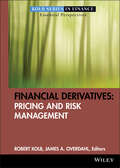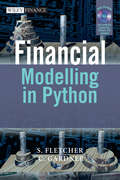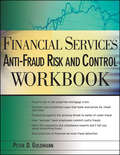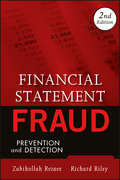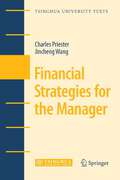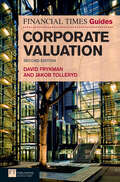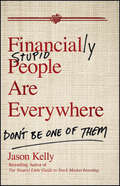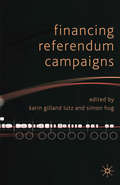- Table View
- List View
Financial and Insurance Formulas
by Tomas CipraFinancial and insurance calculations become more and more frequent and helpful for many users not only in their profession life but sometimes even in their personal life. Therefore a survey of formulas of ?nancial and insurance mathematics that can be applied to such calculations seems to be a suitable aid. In some cases one should use instead of the term formula more suitable terms of the type method, p- cedure or algorithm since the corresponding calculations cannot be simply summed up to a single expression, and a verbal description without introducing complicated symbols is more appropriate. The survey has the following ambitions: • The formulas should be applicable in practice: it has motivated their choice for this survey ?rst and foremost. On the other hand it is obvious that by time one puts to use in practice seemingly very abstract formulas of higher mathematics, e.g. when pricing ?nancial derivatives, evaluating ?nancial risks, applying accou- ing principles based on fair values, choosing alternative risk transfers ARL in insurance, and the like. • The formulas should be error-free (though such a goal is not achievable in full) since in the ?nancial and insurance framework one publishes sometimes in a h- tic way various untried formulas and methods that may be incorrect. Of course, the formulas are introduced here without proofs because their derivation is not the task of this survey.
The Financial Crisis: Who is to Blame?
by Howard DaviesThere is still no consensus on who or what caused the financial crisis which engulfed the world, beginning in the summer of 2007. A huge number of suspects have been identified, from greedy investment bankers, through feckless borrowers, dilatory regulators and myopic central bankers to violent video games and high levels of testosterone among the denizens of trading floors. There is not even agreement on whether the crisis shows a need for more government intervention in markets, or less: some maintain that government encouragement of home ownership lay at the heart of the problem in the US, in particular. In The Financial Crisis Howard Davies charts a course through these arguments, and the evidence advanced for each of them. The reader can thereby assess the weight to be attached to each, and the likely effectiveness of the remedies under development.
Financial Cryptography and Data Security: FC 2010 Workshops, WLC, RLCPS, and WECSR, Tenerife, Canary Islands, Spain, January 25-28, 2010, Revised Selected Papers (Lecture Notes in Computer Science #6054)
by Radu Sion Reza Curtmola Sven Dietrich Aggelos Kiayias Josep M. Miret Kazue Sako Francesc SebéThis volume contains the workshopproceedings of the accompanying workshops of the 14th Financial Cryptograpy and Data Security International Conference 2010, held on Tenerife, Canary Islands, Spain, January 25-28, 2010. FinancialCryptographyandData Securityis a majorinternationalforumfor research, advanced development, education, exploration, and debate regarding information assurance, with a speci?c focus on commercial contexts. The c- ference covers all aspects of securing transactions and systems and especially encourages original work focusing on both fundamental and applied real-world deployments on all aspects surrounding commerce security. Three workshops were co-located with FC 2010: the Workshop on Real-Life CryptographicProtocolsandStandardization(RLCPS),theWorkshoponEthics in Computer Security Research (WECSR), and the Workshop on Lightweight Cryptography for Resource-Constrained Devices (WLC). Intimate and colorful by tradition, the high-quality program was not the only attraction of FC. In the past, FC conferences have been held in highly research-synergistic locations such as Tobago, Anguilla, Dominica, Key West, Guadelupe, Bermuda, the Grand Cayman, and Cozumel Mexico. 2010 was the ?rst year that the conference was held on European soil, in the Spanish Canary Islands, in Atlantic waters, a few miles across Morocco. Over 100 researchers from more than 20 countries were in attendance.
Financial Derivatives: Pricing and Risk Management (Robert W. Kolb Series #5)
by Kolb Robert W. Overdahl James A.Essential insights on the various aspects of financial derivatives If you want to understand derivatives without getting bogged down by the mathematics surrounding their pricing and valuation, Financial Derivatives is the book for you. Through in-depth insights gleaned from years of financial experience, Robert Kolb and James Overdahl clearly explain what derivatives are and how you can prudently use them within the context of your underlying business activities. Financial Derivatives introduces you to the wide range of markets for financial derivatives. This invaluable guide offers a broad overview of the different types of derivatives-futures, options, swaps, and structured products-while focusing on the principles that determine market prices. This comprehensive resource also provides a thorough introduction to financial derivatives and their importance to risk management in a corporate setting. Filled with helpful tables and charts, Financial Derivatives offers a wealth of knowledge on futures, options, swaps, financial engineering, and structured products. Discusses what derivatives are and how you can prudently implement them within the context of your underlying business activities Provides thorough coverage of financial derivatives and their role in risk management Explores financial derivatives without getting bogged down by the mathematics surrounding their pricing and valuation This informative guide will help you unlock the incredible potential of financial derivatives.
Financial Derivatives: Pricing and Risk Management (Robert W. Kolb Series #5)
by Robert Kolb James A. Overdahl Robert W. KolbEssential insights on the various aspects of financial derivatives If you want to understand derivatives without getting bogged down by the mathematics surrounding their pricing and valuation, Financial Derivatives is the book for you. Through in-depth insights gleaned from years of financial experience, Robert Kolb and James Overdahl clearly explain what derivatives are and how you can prudently use them within the context of your underlying business activities. Financial Derivatives introduces you to the wide range of markets for financial derivatives. This invaluable guide offers a broad overview of the different types of derivatives-futures, options, swaps, and structured products-while focusing on the principles that determine market prices. This comprehensive resource also provides a thorough introduction to financial derivatives and their importance to risk management in a corporate setting. Filled with helpful tables and charts, Financial Derivatives offers a wealth of knowledge on futures, options, swaps, financial engineering, and structured products. Discusses what derivatives are and how you can prudently implement them within the context of your underlying business activities Provides thorough coverage of financial derivatives and their role in risk management Explores financial derivatives without getting bogged down by the mathematics surrounding their pricing and valuation This informative guide will help you unlock the incredible potential of financial derivatives.
Financial Economics: A Concise Introduction to Classical and Behavioral Finance
by Thorsten Hens Marc Oliver RiegerFinancial economics is a fascinating topic where ideas from economics, mathematics and, most recently, psychology are combined to understand financial markets. This book gives a concise introduction into this field and includes for the first time recent results from behavioral finance that help to understand many puzzles in traditional finance. The book is tailor made for master and PhD students and includes tests and exercises that enable the students to keep track of their progress. Parts of the book can also be used on a bachelor level. Researchers will find it particularly useful as a source for recent results in behavioral finance and decision theory.
Financial Globalization: Growth, Integration, Innovation and Crisis
by D. DasThe recent crisis has redrawn attention to financial globalization. Dilip Das examines under what circumstances it can be welfare-enhancing and lead to rapid economic growth. Written in an accessible style, the book gives the latest insights on the topic.
Financial Instability: Toolkit for Interpreting Boom and Bust Cycles (Palgrave Macmillan Studies in Banking and Financial Institutions)
by V. D'Apice G. FerriThis book explains what is behind the wave of increasingly frequent and severe financial crises since the 1980s. It links theoretical and policy misconceptions to explain, in plain words, why and how global finance needs fixing. Otherwise, the world may not withstand the next, even bigger, financial crisis.
Financial Institutions and Markets: The Financial Crisis: An Early Retrospective (Innovations In Financial Markets And Institutions Ser. #6)
by Robert R. Bliss George G. KaufmanThis book is a collection of research papers that contribute to the understanding of ongoing developments in financial institutions and markets both in the United States and globally, including an in-depth look at topics such as universal access, cost recovery, and payment services; the transparency of global monetary policy; and the crisis of financial regulation.
Financial Institutions and Markets (PDF)
by Jeff MaduraWith its proven conceptual framework and clear presentation, Financial Institutions and Markets, can help you understand why financial markets exist, how financial institutions serve those markets, and the various services those institutions offer.
Financial Internal Controls Best Practices (Wiley Global Finance Executive Select #1)
by Anthony TarantinoThis chapter from Governance, Risk, and Compliance Handbook, edited by Anthony Tarantino, provides an overview of best practices for financial internal controls. It covers COSO II guidance, automation of controls, and other primary considerations. It also discusses how to achieve ROI on compliance investments.
Financial Law in the Netherlands
by Marcel C. A. van den NieuwenhuijzenThe Netherlands is one of a handful of countries in which bank enterprise and national financial law give rise to a large number of international financial transactions. It is important then for practitioners in other countries to gain more than a notional understanding of the specific features of Dutch financial law, as well as a clear working knowledge of how Dutch financial law interacts with supranational regulatory and policy regimes affecting financial transactions. Toward this end, this very useful book provides a practical but nevertheless thorough survey of Dutch financial law, with lucid explanations of such topics as the following: specific rules applicable to investment institutions; specific rules applicable to debt instruments; offering securities in both primary and secondary markets; set-off and calculation of obligations of market participants (netting); structures for custody and book-entry transfer of securities; obtaining and terminating listings; mandatory bids, competing bids, friendly and unfriendly bids under public offering regulations; alternative investment funds and fund governance; meaning, jargon and function of derivatives, forwards, futures, options, swaps, etc.; securities repurchase and lending transactions; covered bond regulations; caretaking duties in private and public law; structure of legal proceedings of a prospectus liability claim; unfair commercial practices rules; case law in insider trading and market manipulation; and securities litigation in Dutch private, criminal, and administrative law. Written in clear, easy-to-follow English, this book makes Dutch financial law accessible to lawyers, business persons, and others whose work entails financial transactions in the Netherlands. It also serves as an admirable text for students and academics in the field of financial law.
Financial Markets and Organizational Technologies: System Architectures, Practices and Risks in the Era of Deregulation (Palgrave Macmillan Studies in Banking and Financial Institutions)
by A. KyrtsisThis book is a valuable companion for everyone who is interested in the historical context of the co-evolution of financial markets and information technologies in the last 30 years. The contributors analyze system architectures and solution technologies in banking and finance by focusing on the particularities of certain practices and risks.
Financial Modelling in Python (The Wiley Finance Series #536)
by Shayne Fletcher Christopher Gardner"Fletcher and Gardner have created a comprehensive resource that will be of interest not only to those working in the field of finance, but also to those using numerical methods in other fields such as engineering, physics, and actuarial mathematics. By showing how to combine the high-level elegance, accessibility, and flexibility of Python, with the low-level computational efficiency of C++, in the context of interesting financial modeling problems, they have provided an implementation template which will be useful to others seeking to jointly optimize the use of computational and human resources. They document all the necessary technical details required in order to make external numerical libraries available from within Python, and they contribute a useful library of their own, which will significantly reduce the start-up costs involved in building financial models. This book is a must read for all those with a need to apply numerical methods in the valuation of financial claims." –David Louton, Professor of Finance, Bryant University This book is directed at both industry practitioners and students interested in designing a pricing and risk management framework for financial derivatives using the Python programming language. It is a practical book complete with working, tested code that guides the reader through the process of building a flexible, extensible pricing framework in Python. The pricing frameworks' loosely coupled fundamental components have been designed to facilitate the quick development of new models. Concrete applications to real-world pricing problems are also provided. Topics are introduced gradually, each building on the last. They include basic mathematical algorithms, common algorithms from numerical analysis, trade, market and event data model representations, lattice and simulation based pricing, and model development. The mathematics presented is kept simple and to the point. The book also provides a host of information on practical technical topics such as C++/Python hybrid development (embedding and extending) and techniques for integrating Python based programs with Microsoft Excel.
Financial Reporting under IFRS: A Topic Based Approach (Wiley Regulatory Reporting Ser. #1)
by Wolfgang Dick Franck Missonier-PieraThe International Financial Reporting Standards are quite different from other sets of accounting standards, and are fundamentally different from US-GAAP, in that they are based on principles, and not on detailed rules. Financial Reporting under IFRS:A topic-based approach offers a global perspective on IFRS by presenting the prescribed rationale and principles and illustrating them through numerous examples from large international companies. It aims to develop the fundamental skills necessary to read and use the information contained in all types of financial statements, through examples, activities, questions and answers. The book is broadly divided into three sections. Section one examines the structure of the Balance Sheet and the Income Statement, their links and the accounting mechanisms used to prepare them. Section two deals with the identification, evaluation and reporting of Balance Sheet items. Section three covers the use of financial statements to analyze a firm’s performance and its risks. Throughout the book special topics are covered, including Derivatives and Hedge accounting (IAS 39), Business Combination (IFRS 3) and Operating Segments (IFRS 8). Financial Reporting under IFRS is ideally suited to the needs of students of accounting and financial reporting, but all users of financial statements, from creditors and investors to suppliers, customers, employees and governments will benefit from its concise, topic-based approach.
Financial Reporting under IFRS: A Topic Based Approach (Wiley Regulatory Reporting #2)
by Wolfgang Dick Franck Missonier-PieraThe International Financial Reporting Standards are quite different from other sets of accounting standards, and are fundamentally different from US-GAAP, in that they are based on principles, and not on detailed rules. Financial Reporting under IFRS:A topic-based approach offers a global perspective on IFRS by presenting the prescribed rationale and principles and illustrating them through numerous examples from large international companies. It aims to develop the fundamental skills necessary to read and use the information contained in all types of financial statements, through examples, activities, questions and answers. The book is broadly divided into three sections. Section one examines the structure of the Balance Sheet and the Income Statement, their links and the accounting mechanisms used to prepare them. Section two deals with the identification, evaluation and reporting of Balance Sheet items. Section three covers the use of financial statements to analyze a firm’s performance and its risks. Throughout the book special topics are covered, including Derivatives and Hedge accounting (IAS 39), Business Combination (IFRS 3) and Operating Segments (IFRS 8). Financial Reporting under IFRS is ideally suited to the needs of students of accounting and financial reporting, but all users of financial statements, from creditors and investors to suppliers, customers, employees and governments will benefit from its concise, topic-based approach.
Financial Services Anti-Fraud Risk and Control Workbook
by Peter GoldmannMyth-busting guidance for fraud preventionin a practical workbook format An excellent primer for developing and implementing an anti-fraud program that works, Financial Services Anti-Fraud Risk and Control Workbook engages readers in an absorbing self-paced learning experience to develop familiarity with the practical aspects of fraud detection and prevention at banks, investment firms, credit unions, insurance companies, and other financial services providers. Whether you are a bank executive, auditor, accountant, senior financial executive, financial services operations manager, loan officer, regulator, or examiner, this invaluable resource provides you with essential coverage of: How fraudsters exploit weaknesses in financial services organizations How fraudsters think and operate The tell-tale signs of different types of internal and external fraud against financial services companies Detecting corruption schemes such as bribery, kickbacks, and conflicts of interest, and the many innovative forms of financial records manipulation Conducting a successful fraud risk assessment Basic fraud detection tools and techniques for financial services companies, auditors, and investigators Fraud prevention lessons from the financial meltdown of 2007-2008 Written by a recognized expert in the field of fraud detection and prevention, this effective workbook is filled with interactive exercises, case studies, and chapter quizzes, and shares industry-tested methods for detecting, preventing, and reporting fraud. Discover how to mitigate fraud risks in your organization with the myth-busting techniques and tools in Financial Services Anti-Fraud Risk and Control Workbook.
Financial Services Anti-Fraud Risk and Control Workbook
by Peter GoldmannMyth-busting guidance for fraud preventionin a practical workbook format An excellent primer for developing and implementing an anti-fraud program that works, Financial Services Anti-Fraud Risk and Control Workbook engages readers in an absorbing self-paced learning experience to develop familiarity with the practical aspects of fraud detection and prevention at banks, investment firms, credit unions, insurance companies, and other financial services providers. Whether you are a bank executive, auditor, accountant, senior financial executive, financial services operations manager, loan officer, regulator, or examiner, this invaluable resource provides you with essential coverage of: How fraudsters exploit weaknesses in financial services organizations How fraudsters think and operate The tell-tale signs of different types of internal and external fraud against financial services companies Detecting corruption schemes such as bribery, kickbacks, and conflicts of interest, and the many innovative forms of financial records manipulation Conducting a successful fraud risk assessment Basic fraud detection tools and techniques for financial services companies, auditors, and investigators Fraud prevention lessons from the financial meltdown of 2007-2008 Written by a recognized expert in the field of fraud detection and prevention, this effective workbook is filled with interactive exercises, case studies, and chapter quizzes, and shares industry-tested methods for detecting, preventing, and reporting fraud. Discover how to mitigate fraud risks in your organization with the myth-busting techniques and tools in Financial Services Anti-Fraud Risk and Control Workbook.
Financial Statement Fraud: Prevention and Detection
by Zabihollah Rezaee Richard RileyPractical examples, sample reports, best practices and recommendations to help you deter, detect, and prevent financial statement fraud Financial statement fraud (FSF) continues to be a major challenge for organizations worldwide. Financial Statement Fraud: Prevention and Detection, Second Edition is a superior reference providing you with an up-to-date understanding of financial statement fraud, including its deterrence, prevention, and early detection. You will find A clear description of roles and responsibilities of all those involved in corporate governance and the financial reporting process to improve the quality, reliability and transparency of financial information. Sample reports, examples, and documents that promote a real-world understanding of incentives, opportunities, and rationalizations Emerging corporate governance reforms in the post-SOX era, including provisions of the SOX Act, global regulations and best practices, ethical considerations, and corporate governance principles Practical examples and real-world "how did this happen" discussions that provide valuable insight for corporate directors and executives, auditors, managers, supervisory personnel and other professionals saddled with anti-fraud responsibilities Expert advice from the author of Corporate Governance and Ethics and coauthor of the forthcoming Wiley textbook, White Collar Crime, Fraud Examination and Financial Forensics Financial Statement Fraud, Second Edition contains recommendations from the SEC Advisory Committee to reduce the complexity of the financial reporting process and improving the quality of financial reports.
Financial Strategies for the Manager (Tsinghua University Texts)
by Charles Priester Jincheng WangPart of Tsinghua University Texts, Financial Strategies for the Manager includes a range of financial management issues such as financial statement analysis, a systematic approach to financial performance appraisal, liquidity management and sales growth, working capital management, budgeting, foreign exchange and interest rate risk management, and a most useful tool not normally understood – EVA. The book is written in a concise and accessible style, minimizing the use of the technical jargon and complicated mathematical formulae. Included exercises enhance student learning and examples bolster ability to understand and use concepts in day-to-day situations. The material was originally developed for a large corporate client in the telecommunications business to assist non-financial managers in understanding financial theories in a practical way. It was expanded and revised into a text for a post-graduate course of the Asia/Pacific Management Co-operative Program, Capilano University, BC, Canada. Charles Priester is a professor at Capilano University of Canada; Jincheng Wang is a professor at the International Business School of Tianjin Foreign Studies University of China.
The Financial Times Guide to Corporate Valuation (The FT Guides)
by David Frykman Jakob Tolleryd‘Understanding valuation is relevant to everyone with an ambition in business. For us a Cevian Capital it is an absolutely critical skill. This book will take you there faster than any other in the field.’ Christer Gardell Former Partner McKinsey, Managing Partner and co-founder of Cevian Capital ‘A handy, accessible and well-written guide to valuation. The authors manage to capture the reader with high-level synthesis as well as more detailed insights in a great way.’Anna StorakersHead of Group Strategy & Corporate Development, Nordea Bank AB, formerly with Goldman Sachs & Co and McKinsey & Co ”If you can envision the future value of a company you are a winner. Make this comprehensive and diligent book on corporate valuation your companion pursuing transactions and you will succeed.”Hans Otterling,Founding Partner, CEO Northzone Capital “Both in my previous position as an investment banker and today as an investor in high growth technology companies, corporate valuation has been a most critical subject. The Financial Times guide to Valuationserves as the perfect introduction to the subject and I recommend it to entrepreneurs as well as fellow private investors." Carl Palmstierna, former Partner Goldman Sachs, Business Angel ‘Not only will Financial Times Guide to Corporate Valuation provide you with the basic understanding of corporate valuation, it also gives you an interesting insight into non-operational challenges that companies will face. And it does it all in an unexpectedly efficient and reader friendly manner. If you want to learn the basics and only have a few hours to spare, invest them into reading this book!’ Daniel HummelHead of Corporate Finance, Swedbank ‘In this highly accessible and reliable introduction to valuation, Messieurs Frykman and Tolleryd have succeeded in selecting only the essential building blocks in a topic that can otherwise be difficult to navigate. Indeed a guide, this book will prove handy to many of us and a breakthrough to some.’ Per Hedberg, Academic Director Stockholm School of Economics Russia ‘This book provides an accessible and informative entry point to the vast topic of valuation. The book covers mechanics as well as how value is linked to intangibles, growth opportunities and industry structure, all the way providing clear examples of every key idea. The authors understand value: they know what is useful, what is practical and what is critical, and give any reader great guidance to the challenge of getting values right.’ Bo Becker Assistant Professor Harvard Business School "I read Frykman & Tolleryds book on Corporate Valuation the first time in the late 90's - the book has not only thought me how to value investments, but also how important it is to focus on long term cashflow when building and leading an organization"Mikael SchillerOwner, Chairman, Acne Studios ‘The easy, no-nonsense approach to corporate valuation.’ Fiona McGuire, Corporate Finance Director FGS Understanding corporate valuation is crucial for all business people in today’s corporate world. No other measure can indicate as completely the current status as well as the future prospects of a company. The Financial Times Guide to Corporate Valuation is a quick, no-nonsense guide to a complex subject. Whether you’re a manager, executive, entrepreneur or student this comprehensive reading guide will help you tailor your learning according to your experience, existing knowledge and time constraints. Using the example of a fictional European telecommunications company, Mobitronics, as a model, it provides key insights into universal issues in corporate valuation and the most commonly used valuation methods. THE ONLY STRAIGHTFORWARD GUIDE TO CORPORATE VALUATION
Financially Stupid People Are Everywhere: Don't Be One Of Them
by Jason KellyA hard-hitting look at achieving financial freedom by avoiding excessive borrowing and spending If you don't actively resist America's culture of debt, you'll end up precisely where the government, banks, and big business want you to be: indentured servitude. The mistakes people make with their money are basic, and avoidable, and unless you understand what they are, you're probably going to repeat them. What you need is someone who can shed light on the obstacles we face and show you how to avoid getting tripped up by them. Financially Stupid People Are Everywhere shows how society is rigged to take as much of your wealth as possible, and simple ways you can resist. It investigates, explains, and offers advice for all those who have fallen into debt, taken a second mortgage, been trapped by credit cards, or found themselves unable to get ahead. Discusses what you can do to stop the destructive cycle of borrowing and spending Illustrates the four major tenets of getting money right Highlights how to avoid the many ways that government, banks, and big business try to trap you with debt To secure your financial future, you must break the dangerous cycle of borrowing and spending, and learn how to guard your wealth against corporate ploys. Financially Stupid People Are Everywhere leads you down the only proven path to financial freedom.
Financially Stupid People Are Everywhere: Don't Be One Of Them
by Jason KellyA hard-hitting look at achieving financial freedom by avoiding excessive borrowing and spending If you don't actively resist America's culture of debt, you'll end up precisely where the government, banks, and big business want you to be: indentured servitude. The mistakes people make with their money are basic, and avoidable, and unless you understand what they are, you're probably going to repeat them. What you need is someone who can shed light on the obstacles we face and show you how to avoid getting tripped up by them. Financially Stupid People Are Everywhere shows how society is rigged to take as much of your wealth as possible, and simple ways you can resist. It investigates, explains, and offers advice for all those who have fallen into debt, taken a second mortgage, been trapped by credit cards, or found themselves unable to get ahead. Discusses what you can do to stop the destructive cycle of borrowing and spending Illustrates the four major tenets of getting money right Highlights how to avoid the many ways that government, banks, and big business try to trap you with debt To secure your financial future, you must break the dangerous cycle of borrowing and spending, and learn how to guard your wealth against corporate ploys. Financially Stupid People Are Everywhere leads you down the only proven path to financial freedom.
Financing Referendum Campaigns
by Karin Gilland Lutz S. HugCritics of referendums often lament that big money may buy success at the ballot box. But spending by interest groups may also be informative for citizens. This can only happen, however, if the financing of referendum campaigns is regulated. This book offers an overview of these regulations and presents research on their effects.
Finanzierung von Familienunternehmen: Eine Analyse spezifischer Determinanten des Entscheidungsverhaltens (Entrepreneurial and Financial Studies)
by Stephanie C. SchramlStephanie C. Schraml analysiert die Determinanten des Finanzierungsverhaltens in Familienunternehmen, wobei sie insbesondere Ziele und Corporate-Governance-Strukturen der Unternehmen fokussiert.



